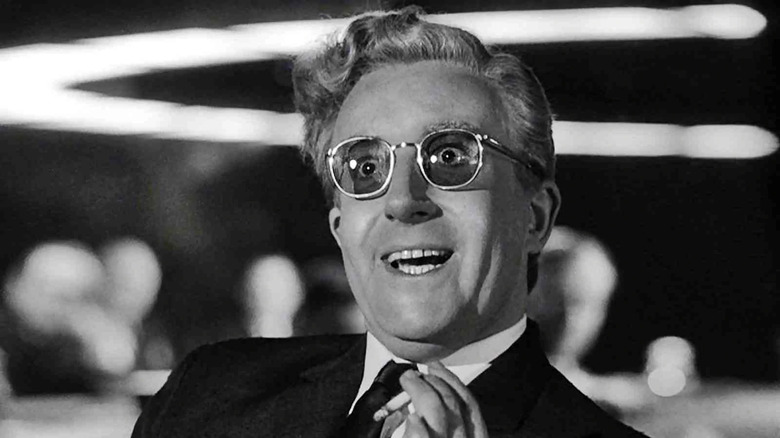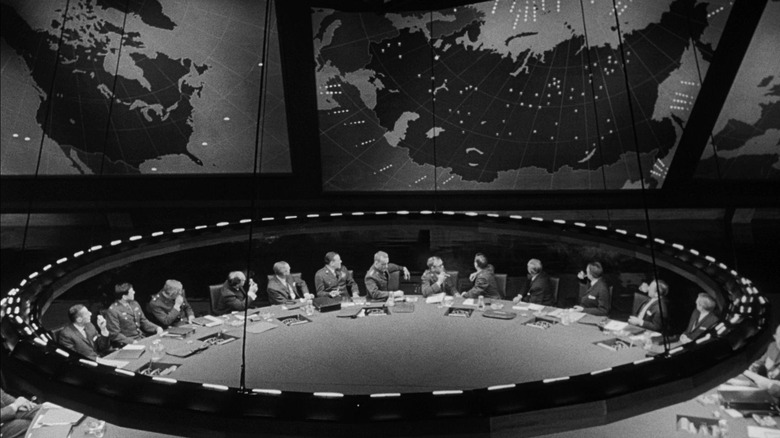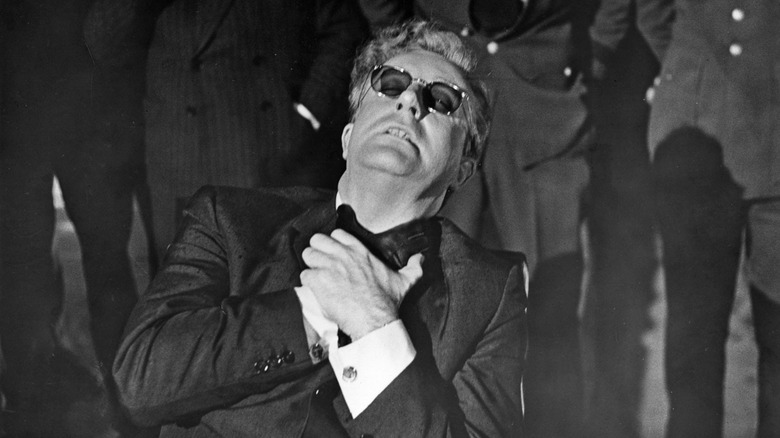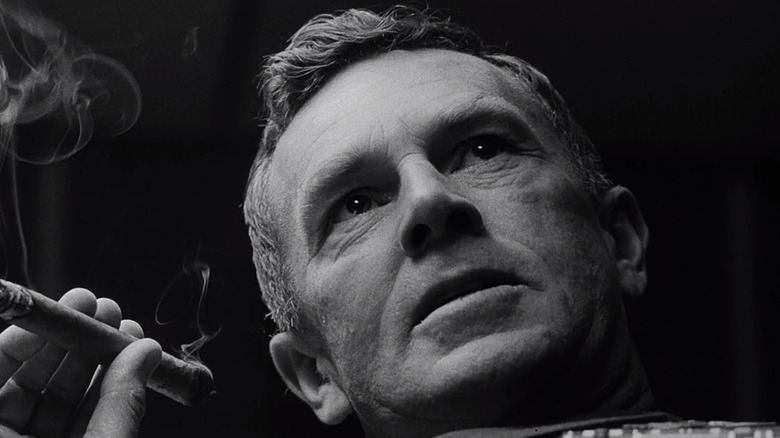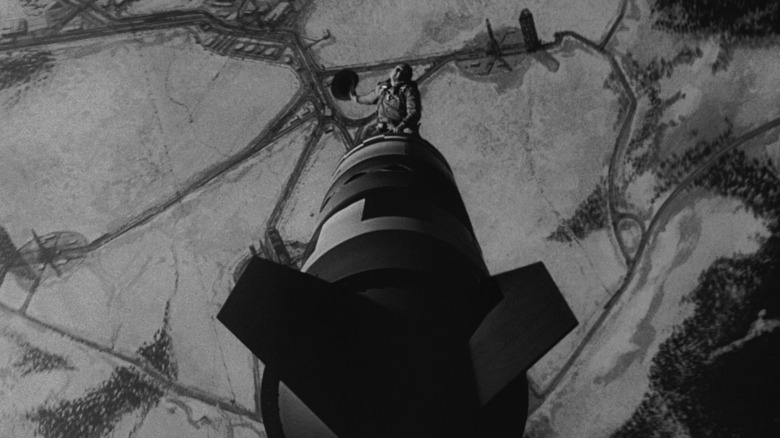Dr. Strangelove Ending Explained: We'll Meet Again
Is nuclear war a suitable subject for comedy? Stanley Kubrick certainly thought so. During his research for his masterful Cold War satire, "Dr. Strangelove or: How I Learned to Stop Worrying and Love the Bomb," he came to see comedy as the only sensible way of doing the subject real justice. Having bought the film rights to Peter George's novel, "Red Alert," he started out with the goal of making a serious drama. Yet the more he found out about thermonuclear war and the concept of mutual assured destruction (MAD), the more absurd the whole thing seemed to him. He explained:
"My idea of doing it as a nightmare comedy came in the early weeks of working on the screenplay. I found that in trying to put meat on the bones and to imagine the scenes fully, one had to keep leaving out of it things which were either absurd or paradoxical, in order to keep it from being funny; and these things seemed to be close to the heart of the scenes in question."
Kubrick's instinct was correct. "Dr. Strangelove" is one of the master director's greatest films, regarded as one of the best comedies ever made while its very serious, similarly-themed rival "Fail Safe" is largely forgotten. It was nominated for four Oscars at the 37th Academy Awards, criminally losing out to "My Fair Lady" on three — Best Picture, Director, and Actor (Peter Sellers). It's a film packed with iconic moments, right down to its tour de force ending. It's pretty clear what happens there – the world ends in a nuclear holocaust — but let's dig into some of the finer points of that magnificently haunting conclusion.
So what happens in Dr Strangelove again?
In a UK air base, US Air Force Brigadier General Jack D. Ripper (Sterling Hayden) has gone insane. Worried about the Soviets sabotaging good old American "precious bodily fluids," he orders his bombers, airborne a few hours flight from targets inside the USSR, to launch a pre-emptive attack. At gunpoint, RAF Group Captain Lionel Mandrake (Peter Sellers) reluctantly follows his orders.
With their radios set only to receive messages preceded by a special code known only to Ripper, the planes head towards their targets. Over in the War Room in the Pentagon, General Buck Turgidson (George C. Scott) relays the bad news to President Muffley (Sellers in another role). It is now a race against time to try recalling the bombers before they drop their nuclear warheads and provoke a massive retaliatory attack from the USSR. Gung-ho Turgidson figures the best way is to go for broke, but then they find out about the Soviet's Doomsday machine.
After General Ripper commits suicide, all the bombers are recalled... apart from one, under the command of Major "King" Kong (Slim Pickens). With the plane's radio damaged and unable to receive the recall signal, they proceed to target as planned. As hope fades, the President turns to ex-Nazi scientist Dr. Strangelove (Sellers yet again) for last minute solutions.
Strangelove is the wackiest and most memorable of the three characters played by Sellers in the film, but of course I would say that: As a Brit I was brought up by shows like "Fawlty Towers" and "'Allo 'Allo!" to find comedy German accents hilarious. The part of Major Kong was also written for the unpredictable comedy genius, but he was worried about nailing the accent. After he also suffered an ankle injury, the role went to Pickens instead. That was perhaps a happy accident, because one more Sellers character might have been too much of a good thing. As great as his three parts are, it is the fantastic performances of Hayden, Scott, and Pickens that really tie the whole thing together and keep me coming back the most.
Is the Dr. Strangelove character based on a real person?
Dr. Strangelove, the sinister wheelchair-bound ex-Nazi scientist acting as an advisor to Professor Muffley, is only in a few scenes but overshadows the whole film. It's such a fascinatingly weird performance from Sellers, squirming around in his chair and struggling with random outbursts that suggest at least part of him is still loyal to his old boss. Add to that his psychotic hand with a mind of its own, and you have the most outright funny character in the movie.
This ridiculous character didn't appear in Peter George's original book, but was a composite of several real-life people. There are elements of Herman Kahn, the strategist who theorized about the prospect of a winnable nuclear war in his 1960 book "On Thermonuclear War" (via New Yorker), and John von Neumann of the Manhattan Project, who helped develop the US's first nuclear weapons and advocated the strategy of MAD. For Sellers, the key inspiration was Wernher von Braun, a leading Nazi rocket scientist who ended up working for the Americans after World War II. Having developed the V-2 rockets that rained down on London in the last year of the conflict, his later work for NASA helped put the first man on the moon.
Von Braun was one of around 1,600 German scientists captured and taken to the United States under the secret intelligence initiative codenamed Operation Paperclip (via History.com). With the Russians doing the same as the Cold War settled in, President Harry Truman had little choice but to sanction the scheme, although he didn't want to take any Nazi party members on board. The CIA's forerunner found ways around that, however, whitewashing records so ex-Nazis like von Braun could play on the American team.
To my knowledge, none of these people suffered from alien hand syndrome. That part was from Sellers, taking a cue from the mad scientist character in Fritz Lang's "Metropolis" and borrowing one of Kubrick's black leather gloves to complete the look.
Was the Doomsday machine a real thing?
Turgidson, clearly influenced by Kahn and his controversial book "On Thermonuclear War," advises the President to go all-in and try knocking out the Soviets first. What's 10-20 million deaths? "I'm not saying we wouldn't get our hair mussed," he admits.
That idea is scuppered when the Russian ambassador gravely announces fearfully that the Soviets have built a Doomsday machine as a nuclear deterrent. It's so new and top secret that the Russian Premier hasn't had chance to announce it yet. As if the prospect of a nuclear exchange isn't bad enough, the device is a whole bunch of nuclear bombs buried in tons of cobalt, rigged to automatically go off if the Soviet Union is ever attacked. By Strangelove's calculations, any survivors they manage to hide away in deep mine shafts would have to wait 100 years before they could emerge again.
The Doomsday machine would be the logical conclusion of the nuclear arms race, resulting in a weapon so destructive that it would all but completely assure the demise of mankind. "Salting" the nukes with cobalt results in the metal turning into highly radioactive cobalt-60 when detonated. Compared to regular nuclear fallout, which decays after a short while, cobalt-60 fallout would render large swathes of the planet completely uninhabitable for many decades (via Nuclear Weapons Archive).
The concept of the Doomsday machine, originating in the '50s, was supposed to be purely hypothetical (via Britannica). However, thanks to its nuclear capabilities, the Russians' "Dead Hand" system was essentially regarded as a Doomsday machine, an automated device with the capability to launch as many warheads as it deemed appropriate in the event that all the Soviet leaders were wiped out. Then, as recently as 2015, rumors surfaced that Russia had developed "a new intercontinental, nuclear-armed, nuclear-powered, undersea autonomous torpedo," or "a kind of doomsday device" (via NPR). Sleep tight, everyone!
We'll meet again...
To the men in the War Room, Strangelove's vision of life in the mine shafts doesn't sound all that bad, busily procreating with a ratio of 10 women to each guy. Then Turgidson starts worrying about a "Mineshaft gap," referencing the concept of a "missile gap." This was when the US government were concerned that they were lagging behind the USSR in terms of missile tech and the amount of warheads at their disposal (via Arms Control).
Strangelove has another plan but then realizes he is on his feet, uttering the immortal line, "Mein Führer, I can walk!" Cut to a montage of mushroom clouds set to "We'll Meet Again," the signature tune of Dame Vera Lynn. The English singer was a beloved "Forces Sweetheart" during WWII, and the sentimental song struck a chord with many people waving goodbye to their loved ones going off to fight.
Less than 20 years after the end of the war, it must have been brutal for many viewers hearing the song used in the context of "Dr. Strangelove." The irony of the lyrics is bitter enough now; if there was a nuclear war, very few people would be meeting anyone else ever again.
There is an extra wrinkle to this. During the Cold War, the BBC made plans for a Wartime Broadcasting System so it could stay on air if there was a nuclear attack (via BBC). A selection of radio shows and tunes was put together to help the public keep their chin up during such an apocalyptic event. One of the songs included was "We'll Meet Again."
Kubrick sure knew how to pair a great tune with an unforgettable image to end a movie. Just think about the Starchild orbiting Earth to "Also Sprach Zarathustra" in "2001: A Space Odyssey" or the steadicam moving in on that ambiguous party photo to "Midnight, The Stars and You" in "The Shining." Setting Vera Lynn to armageddon was a stroke of genius, giving us one of the most chillingly beautiful film endings of all time.
